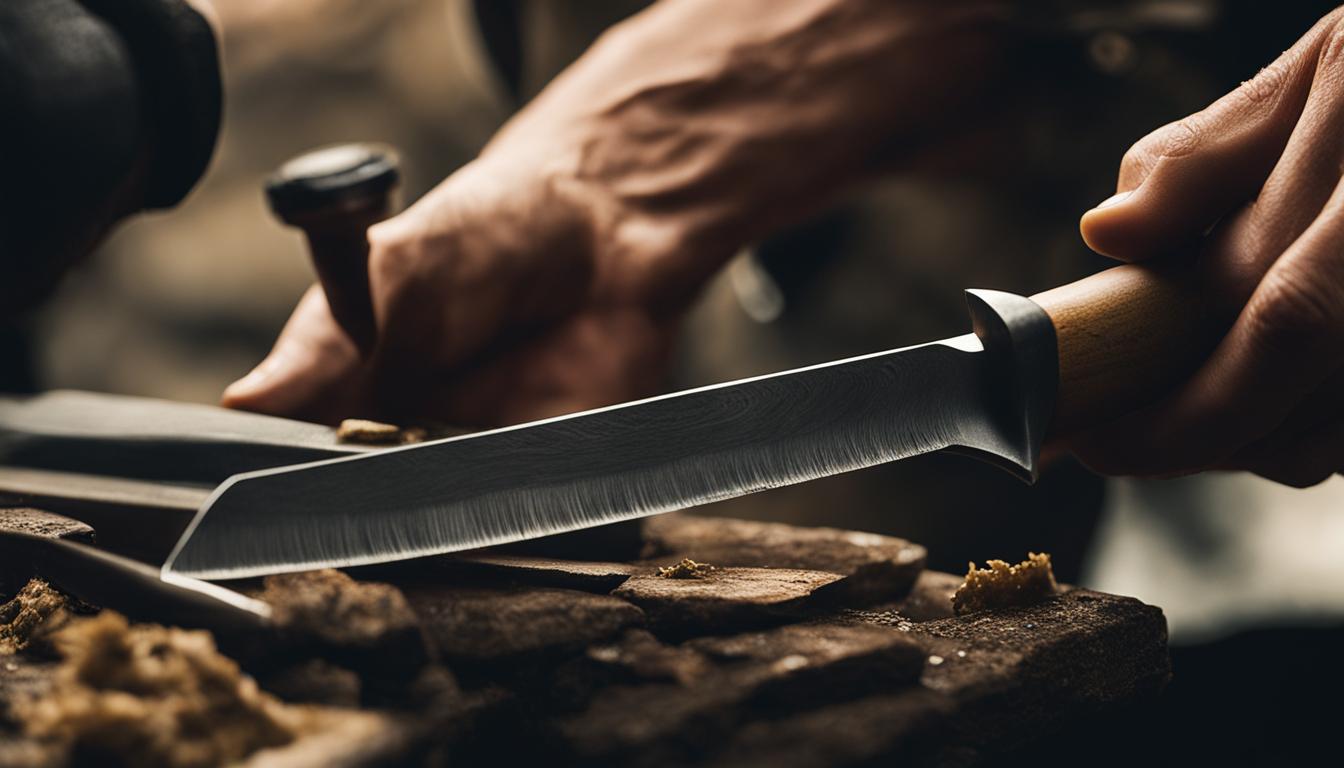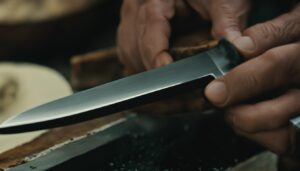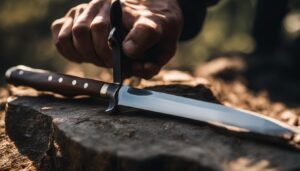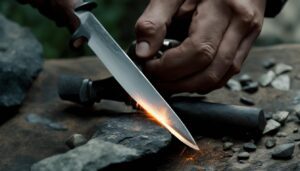Learning how to sharpen your hunting knife is essential for maintaining a sharp and effective cutting edge. With a variety of sharpening techniques available, it’s important to understand the best methods for achieving a precise and durable edge.
Key Takeaways:
- Regularly sharpening your hunting knife is crucial for optimal cutting performance.
- Understanding the hardness of your knife’s steel and choosing the right maintenance routine is important for blade longevity.
- Choosing the appropriate sharpening stone is essential for achieving a razor-sharp edge.
- Mastering the sharpening technique involves maintaining a consistent angle and using the same number of strokes on each side of the blade.
- The step-by-step sharpening process involves testing the blade, using a sharpening stone with honing oil, and finishing with a smooth stone.
By avoiding common pitfalls and implementing helpful tips and tricks, you can become proficient in sharpening your hunting knife, ensuring it’s always ready for your outdoor adventures.
Understanding Knife Hardness and Blade Maintenance
When it comes to hunting knives, understanding the hardness of the blade is crucial for proper maintenance and sharpening. Different knives are made from varying steel hardness, which affects their overall sharpness and durability. Knives with harder steel require more effort to sharpen, but they also retain their edge for a longer time. On the other hand, knives with softer steel may sharpen more easily but can dull more quickly with use. To ensure your hunting knife remains in optimal condition, it’s important to choose the right maintenance routine.
Proper blade maintenance starts with regular cleaning and drying to prevent rust and corrosion. For knives with harder steel, honing the blade regularly using a honing rod can help maintain the edge between sharpening sessions. It’s also important to avoid using your hunting knife for tasks that it’s not designed for, as this can cause unnecessary wear and tear on the blade.
Additionally, regular inspections of the blade for any signs of damage or wear are essential. Look for chips, cracks, or any other abnormalities that may affect the knife’s performance. If you notice any issues, it’s best to address them promptly to prevent further damage and ensure your hunting knife is always ready for action.
| Knife Hardness | Pros | Cons |
|---|---|---|
| Harder Steel | Retains edge longer | Requires more effort to sharpen |
| Softer Steel | Sharpen more easily | May dull more quickly |
By understanding the knife hardness and implementing proper blade maintenance techniques, you can ensure your hunting knife remains sharp, reliable, and ready for any outdoor adventure.
Selecting the Right Sharpening Stone
When it comes to sharpening your hunting knife, choosing the right sharpening stone is crucial. Different knives require different types of stones to achieve the best results. Traditional whetstones are a popular choice and work well for many knives. However, for today’s super-hard steel blades, a fine-grit diamond stone is recommended. The diamond stone offers superior durability and abrasiveness, making it ideal for sharpening high-quality hunting knives.
If you prefer a more versatile option, consider a 3-way stone system. These systems typically include coarse, medium, and fine-grit stones, allowing you to start with rough sharpening and progress to a polished edge. This flexibility makes 3-way stones suitable for various knives and skill levels. Additionally, their compact size makes them convenient for traveling or outdoor use.
For those who prioritize convenience and portability, handheld sharpeners are a great choice. These compact tools often come with built-in angle guides to help you maintain a consistent sharpening angle. Portable sharpeners are designed for quick touch-ups in the field, allowing you to keep your hunting knife sharp even when away from your workshop.
| Sharpening Stone Type | Advantages |
|---|---|
| Traditional Whetstones | – Suitable for many knives – Offers a traditional sharpening experience |
| Diamond Stones | – Ideal for super-hard steel blades – Provides superior durability and abrasiveness |
| 3-Way Stone Systems | – Offers versatility with coarse, medium, and fine-grit stones – Compact and travel-friendly |
| Handheld Sharpeners | – Convenient and portable – Often includes built-in angle guides |
Before making your decision, consider the type of hunting knife you have and the level of convenience you desire. Whether you choose a traditional whetstone, diamond stone, 3-way system, or handheld sharpener, the key is to select a stone that suits your needs and offers the right level of abrasiveness for your knife. By investing in the right sharpening stone, you can ensure your hunting knife is always sharp and ready for any outdoor adventure.
Mastering the Sharpening Technique
When it comes to sharpening your hunting knife, mastering the technique is crucial for achieving a precise and long-lasting edge. The consistency of the angle and the number of strokes used are key factors in ensuring a sharp blade that can effectively handle your hunting tasks. Let’s explore some tips to help you perfect your sharpening technique.
Consistent Angle
One of the most important aspects of sharpening a knife is maintaining a consistent angle throughout the process. Whether you choose a 20-degree angle, 25-degree angle, or any other angle suitable for your knife, it’s essential to hold that angle consistently across the entire length of the blade. This consistency ensures that the edge is sharpened evenly, resulting in a symmetrical blade that performs optimally.
Number of Strokes
In addition to maintaining a consistent angle, it’s also crucial to use the same number of strokes on each side of the blade. This ensures equal sharpening and prevents one side from becoming sharper than the other. While the specific number of strokes may vary depending on your knife and its condition, aiming for a balanced approach helps maintain a well-rounded edge.
Take your time and sharpen your knife with patience, focusing on maintaining a consistent angle and using the same number of strokes. Remember that practice makes perfect, and as you gain more experience, you’ll develop a steady hand and a keen eye for achieving a razor-sharp edge.
Step-by-Step Sharpening Process
Now that we understand the importance of selecting the right sharpening stones and honing oil, let’s dive into the step-by-step sharpening process. Follow these instructions to achieve a razor-sharp edge on your hunting knife:
- Test the Blade: Before starting the sharpening process, it’s important to assess the level of sharpness of your hunting knife blade. Test it on a piece of paper and take note of how it performs.
- Prepare the Sharpening Stone: Use a mounted sharpening stone and apply a few drops of honing oil to create a smooth and lubricated surface. This will prevent slippage and ensure a consistent sharpening experience.
- Set the Blade Angle: Hold the hunting knife blade at a consistent 25-degree angle. This angle is generally recommended for hunting knives, but you can adjust it based on your personal preference and the type of blade you’re sharpening.
- Apply Pressure and Draw the Blade: With moderate pressure, draw the blade across the sharpening stone, moving from the base of the blade to the tip. Repeat this motion several times on one side of the blade before switching to the other side.
- Achieve Desired Sharpness: Continue sharpening until you achieve the desired level of sharpness. Remember to maintain a consistent angle and use the same number of strokes on each side of the blade.
- Finish with Honing: Once the desired sharpness is achieved, switch to a smooth sharpening stone and add a few drops of honing oil. Hone the blade on this stone to give it a final touch and refine the sharp edge.
Following this step-by-step process will ensure that your hunting knife is sharpened to perfection. Remember to take your time, be patient, and focus on maintaining a consistent angle throughout the sharpening process. With practice, you’ll become a master at sharpening your hunting knife and enjoy the benefits of a razor-sharp blade.
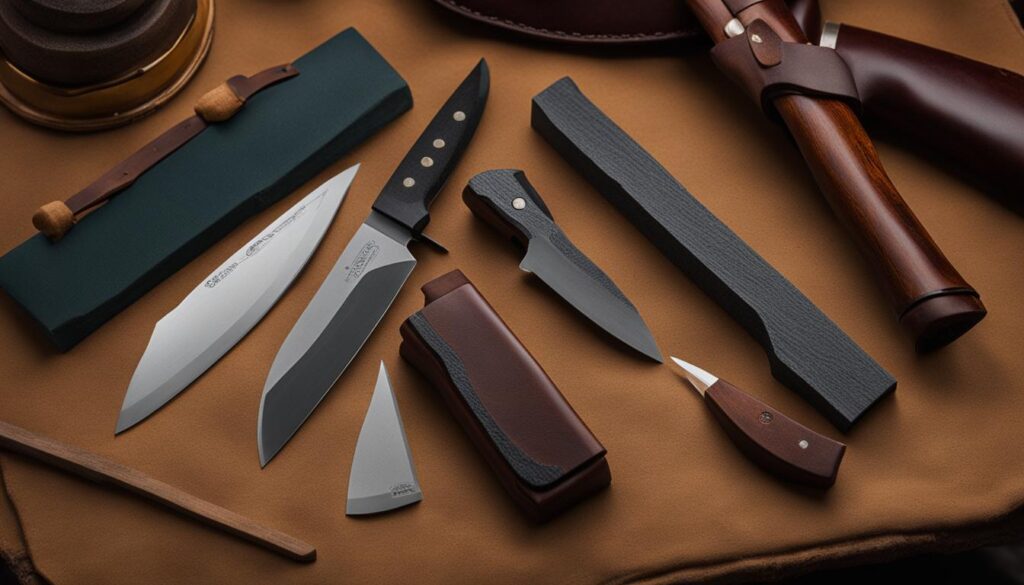
Table 1: Recommended Sharpening Stones
| Sharpening Stone | Stone Type | Grit Level | Best For |
|---|---|---|---|
| Traditional Whetstone | Natural or Synthetic | Medium to Fine | General Knife Sharpening |
| Diamond Stone | Artificial (Diamond-coated) | Extra Fine | Super-Hard Steel Blades |
| 3-Way Stone System | Combination of Different Stones | Coarse to Fine | Versatile Sharpening Options |
| Handheld Sharpener | Compact and Portable | Varying Grit Levels | Convenient Field Use |
Pitfalls to Avoid When Sharpening Your Hunting Knife
Sharpening your hunting knife requires precision and attention to detail. While it may seem straightforward, there are several common pitfalls that can hinder your sharpening process and affect the overall performance of your knife. By being aware of these pitfalls and taking the necessary precautions, you can ensure that you achieve optimal sharpening results.
Changing Angle
One of the most common mistakes when sharpening a hunting knife is changing the angle as you sharpen. Maintaining a consistent angle throughout the sharpening process is crucial for achieving a consistent and even edge. Deviating from the original angle can lead to an uneven edge, making it difficult to achieve the desired sharpness. To avoid this pitfall, it’s important to maintain a steady hand and pay close attention to the angle of the blade as you sharpen.
Cheap Sharpening Equipment
The quality of your sharpening equipment can greatly impact the outcome of your sharpening efforts. Using cheap or low-quality sharpening stones or systems may not provide the desired results and can even damage your knife. Investing in high-quality sharpening equipment will not only yield better results but also ensure the longevity of your knife. Look for reputable brands and read reviews before purchasing any sharpening equipment to avoid this pitfall.
Overlooking Maintenance
Proper maintenance of your hunting knife is essential for keeping it in optimal condition. Failing to clean and oil your knife regularly can lead to rust and corrosion, making it more difficult to achieve a sharp edge. Additionally, neglecting to store your knife properly can also impact its performance. Always clean and dry your knife after use, apply a thin coat of oil to prevent rust, and store it in a sheath or protective case. By prioritizing maintenance, you can avoid unnecessary pitfalls and ensure that your knife stays sharp and ready for your next hunting adventure.
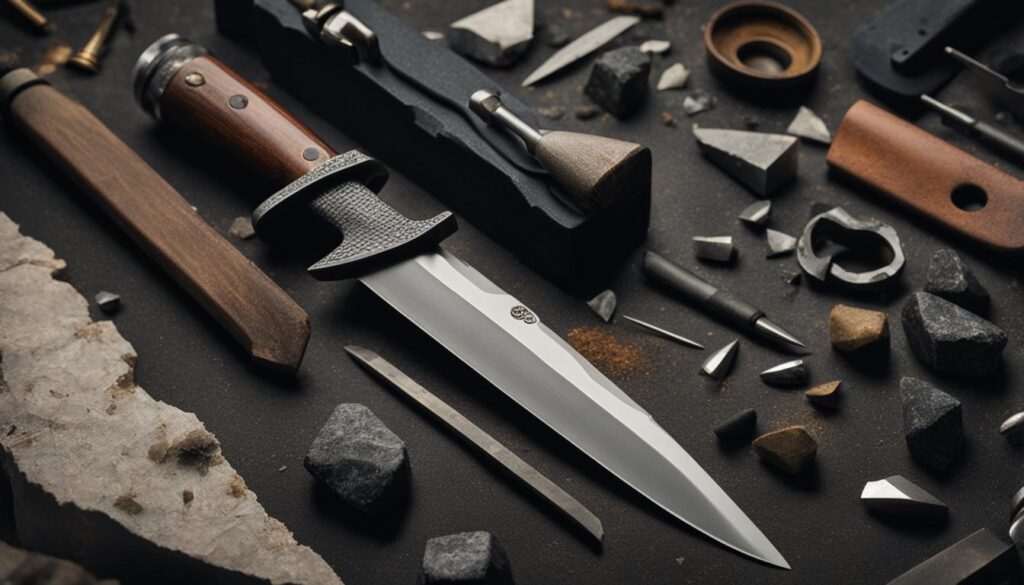

Tips and Tricks for Knife Sharpening
When it comes to sharpening your hunting knife, there are a few tips and tricks that can take your technique to the next level. These simple hacks can help you achieve a razor-sharp edge and make the sharpening process more efficient.
Creating an Angle Guide
One of the key factors in successful knife sharpening is maintaining a consistent angle. To ensure that you’re sharpening at the correct angle, you can create your own angle guide using a sheet of paper. Fold the paper into a triangle and hold it against the blade, aligning it with the desired sharpening angle. This DIY guide will help you maintain the proper angle as you sharpen your knife.
Using a Sharpie Marker
A Sharpie marker can be a valuable tool when sharpening your knife. Before you begin sharpening, use the marker to mark the bevel of the blade. As you sharpen, the marks will be gradually removed, indicating that you are effectively removing material from the blade. This visual cue can help you monitor your progress and ensure that you’re sharpening evenly.
Innovative Knife Sharpening Hack
Need to touch up your knife’s edge but don’t have a sharpening stone on hand? Look no further than your kitchen cupboard. A ceramic coffee mug can serve as a makeshift sharpening tool. Simply turn the mug upside down and use the unglazed ring on the bottom to sharpen your knife. This hack is perfect for those unexpected moments when you need a quick and temporary solution.
| Tip | |
|---|---|
| 1 | Use a DIY angle guide made from a sheet of paper to maintain a consistent sharpening angle. |
| 2 | Mark the bevel of the blade with a Sharpie marker before sharpening to monitor your progress. |
| 3 | In a pinch, use the unglazed ring on the bottom of a ceramic coffee mug to sharpen your knife’s edge. |
By incorporating these tips and tricks into your knife sharpening routine, you can enhance your skills and achieve a finely honed edge on your hunting knife. Remember to always prioritize safety and precision throughout the sharpening process for optimal results.
Conclusion
In conclusion, mastering the art of sharpening techniques is vital for maintaining the performance of your hunting knife and ensuring a safe and effective hunting experience. By understanding the different methods available, selecting the right equipment, and following the proper sharpening process, you can keep your hunting knife sharp and ready for any outdoor adventure.
Regular blade maintenance is crucial in preserving the longevity of your hunting knife. By taking the time to care for and sharpen your blade, you can extend its lifespan and ensure it remains in optimal condition for your hunting needs.
Remember, sharpening techniques are not a one-size-fits-all approach. It’s important to consider the specific needs of your hunting knife and adjust your sharpening techniques accordingly. Experiment with different methods and find what works best for you and your blade.
So, the next time you head out for a hunting trip, make sure your hunting knife is properly sharpened and maintained. With the right sharpening techniques and blade maintenance, you can rely on your hunting knife to provide you with a sharp and reliable tool for all your outdoor adventures.
FAQ
How often should I sharpen my hunting knife?
The frequency of sharpening your hunting knife depends on how often you use it and the type of cutting tasks performed. As a general guideline, it’s recommended to sharpen your knife at least once or twice a hunting season or whenever you notice a decrease in cutting performance.
What is the best angle for sharpening a hunting knife?
For hunting knives, a 25-degree angle is generally recommended. This angle provides a good balance between sharpness and durability. However, the specific angle can vary depending on the knife’s intended use and the user’s preference.
Can I use a regular whetstone to sharpen my hunting knife?
Traditional whetstones can be suitable for sharpening many hunting knives. However, for knives made with super-hard steel, such as some modern blades, a fine-grit diamond stone is recommended for optimal results.
How can I maintain a consistent angle while sharpening?
One way to maintain a consistent angle is by creating your own angle guide using a sheet of paper. By drawing a line at the desired angle, you can use it as a reference point while sharpening. Additionally, practicing with a sharpening guide or watching tutorial videos can help develop muscle memory for maintaining consistent angles.
What are some common pitfalls to avoid when sharpening a hunting knife?
One common pitfall is changing the angle while sharpening. This can lead to inconsistent results and uneven edge bevels. It’s important to maintain a steady angle throughout the sharpening process. Additionally, using cheap knives and sharpening equipment can hinder the sharpening process and result in subpar results.
Can I use a ceramic coffee mug to sharpen my hunting knife?
In a pinch, a ceramic coffee mug can be used to touch up a knife’s edge. By using the unglazed bottom rim of the mug, you can lightly run the blade against it at a consistent angle to improve sharpness. However, this method is not suitable for major sharpening or maintaining a precise angle.
